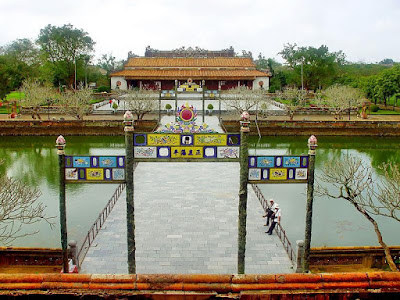 |
| hue citadel |
Thanh Toan Bridge
 |
| Thanh Toan Bridge |
Thanh Toan Bridge, an ancient bridge with special architecture, is located in Thanh Thuy Chanh Village, about 8km from Hue City to the east. Undergoing ups and downs of time and history, the bridge remains its own featured architectural style. Near the bridge, it is a large ground where locals gather to organize many activities. The bridge is also a "communal house" where community activities have been taking place for a long time. Apart from folk mark festival held every two years on the third day of the first lunar month, Bai Choi festival is also held here. This is a long-lasting folk game bearing Vietnamese culture and identity. In Northern Vietnam, there are two most famous tile-covered bridges: Khuc Thoai Bridge and Phu Khe Bridge. Thanh Toan Bridge in North Central Coast Vietnam and Japanese Covered Bridge in Hoi An (South Central Coast) are two well-known ones. The bridge has particular architectural motif and highest artistic value among bridges in Vietnam.
Ngo Mon Gate
 |
| Ngo Mon Gate |
Ngo Mon Gate is not just as simple as a gate, but also a whole complex architecture. Above the gate, there is Ngu Phung Pavillion (Pavilion of Five Phoenixes) where some important court ceremonies used to be taken place. Here is also the place where the abdication ceremony of the last Vietnamese emperor occurred on August 30 1945. Ngo Mon Gate is a monumental and palatial complex architecture - one of the highest architectures of Hue Citadel. The total height of Ngo Mon Gate is 14.80 meters. The grandness and beauty of the gate creates a "mutation" in space and impresses visitors coming to Hue Imperial Citadel. The work was built under the power of Ming Mang Emperor. Though Mgo Mon Gate is quite similar to Tiananmen (China), Minh Mang Emperor's architects had creation and high skill in designing and decorating. Thus, Ngo Mon Gate becomes a beautiful architectural work closed to the natural landscapes, emotions and souls of Vietnamese people in general and locals in Hue in particular.
Thai Hoa Palace
 |
| Thai Hoa Palace |
Thai Hoa Palace is located in the inner area of Hue Citadel. It is the enthronement place of 13 Nguyen Dynasty's emperors, from Gia Long to Bao Dai. Hue Citadel used to be the center of this country. Thai Hoa Palace is the most important architecture in Hue Citadel. Here is the place where Nguyen Dynasty's emperors sat on the throne and ruled the country for over 100 years. It is considered that the name of Thai Hoa Palace is a criteria, a desire of Nguyen Dynasty about a peaceful and wealthy country. Among tens of palaces in Hue Imperial Citadel, Thai Hoa Palace is the most beautiful, biggest palace, located in the most prominent position. If Ngo Mon Gate is considered as the "facade" of Hue Citadel, Thai Hoa Palace is the "heart" where there is throne of emperors. Thai Hoa Palace is the land of dragons.
Thai Hoa Palace, like other imperial architectural works in Hue, has the solemn contemplation as its architectural style, but not overcast and boring. The architecture is the harmonic combination of criteria in the imaging method and the relation with exterior, garden and nature. Thai Hoa Palace is a typical work in Hue imperial as well as palatial architectures. Thai Hoa Palace is the convergence of quintessence of architectural decorative art, construction techniques of Nguyen Dynasty, creating a very unique style of Hue. It can be said that Thai Hoa Palace is the zenith of Hue imperial architectural art.
ReplyDeletehãng vé máy bay eva
phòng vé máy bay đi mỹ
văn phòng korean air tại việt nam
tìm vé máy bay đi mỹ
vé máy bay đi canada giá rẻ
Nhung Chuyen Di Cuoc Doi
Ngau Hung Du Lich
Tri Thuc Du Lich